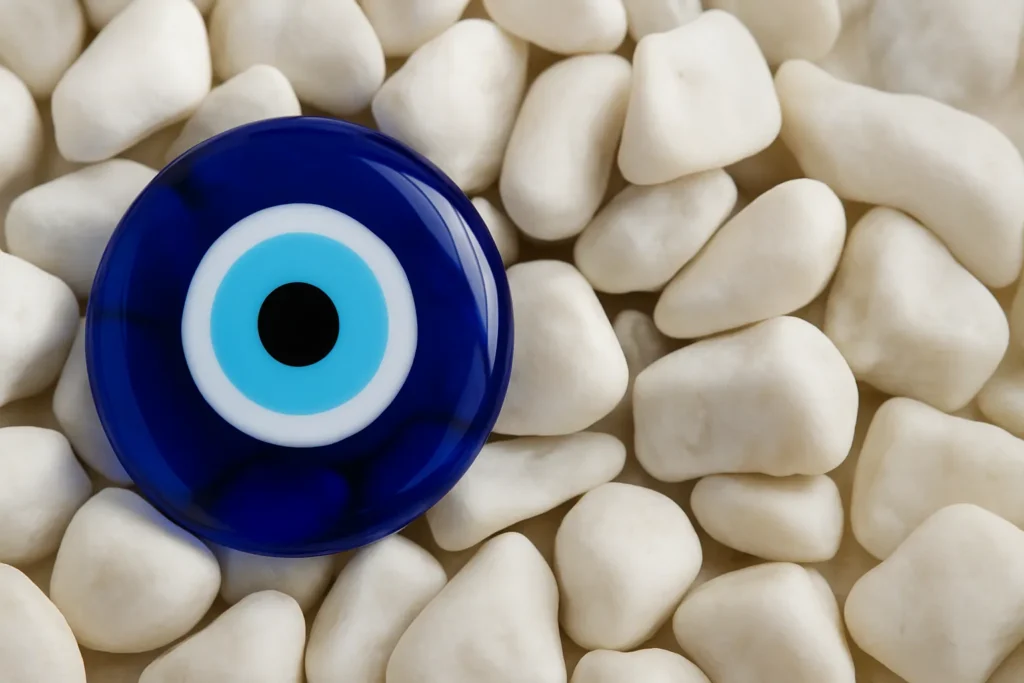If you’ve ever spotted the little blue-and-white eye charm hanging in a Greek home, worn on a bracelet, or even inked as a tattoo, you’ve already met the Greek evil eye, also called mati. It’s one of the most recognizable symbols in Greek culture, carrying both mystery and meaning.
So, what does the Greek evil eye mean? In simple words, it’s the belief that a strong gaze—often born from envy or admiration—can bring misfortune or sickness. To guard against this, people in Greece have turned to protective charms, prayers, and rituals for centuries.
But is the evil eye Greek in origin, or is it shared across cultures? That’s what makes it fascinating: while the belief exists in many Mediterranean and Middle Eastern traditions, the Greek version has its own unique story, deeply tied to history, religion, and daily life.
In this guide, we’ll explore the origins of the evil eye in Greece, the symbolism behind the mati, protective rituals, its role in jewelry and tattoos, and even answer common questions people often have about it. By the end, you’ll not only understand the cultural weight of this symbol—you’ll see why it continues to hold such a powerful place in Greek tradition today.
1. What Is the Greek Evil Eye?
In Greece, the evil eye is known as mati (Μάτι) or sometimes kakó máti (Κακό μάτι), which translates to “bad eye.” At its core, the idea is simple yet powerful: a person’s gaze, especially when filled with envy or excessive admiration, can unintentionally cause harm. This harm may show up as sudden headaches, fatigue, loss of appetite, or just a run of bad luck.
So, is the evil eye good or bad? The answer depends on how it’s understood. On one hand, it’s viewed as harmful—something to be wary of, a force that can disrupt health or happiness. On the other hand, the belief in the evil eye has led to the creation of protective symbols, prayers, and charms that are seen as good, even sacred. In this sense, it’s both a warning and a shield.
You’ll also find the mati woven into everyday Greek expressions. If someone compliments a baby, a new car, or even a fresh haircut, it’s not unusual for them to add a phrase like “Na mi se matiáso” (“May I not give you the evil eye”). Parents and grandparents might even make a small gesture of spitting—three quick puffs—to protect loved ones from unwanted energy.
In short, the Greek evil eye isn’t just an old superstition. It’s a living tradition, shaping language, behavior, and rituals in daily life.
2. Historical Background
The belief in the Greek evil eye stretches back thousands of years, with its roots firmly planted in the world of ancient Greece. Writers like Hesiod and Plutarch described the dangers of an envious glance, while Plato mentioned how the human eye was thought to carry a kind of power that could affect others. To the Greeks, the idea that a person’s gaze could transmit energy—whether positive or negative—was not superstition but a genuine force of nature.
Archaeologists have found eye motifs painted on pottery, drinking vessels, and amulets dating back to classical times. These weren’t just artistic choices; they were created as apotropaic symbols—objects designed to ward off evil. Even today, you’ll see echoes of these same designs in the blue-and-white charms sold across Greece.
The concept didn’t remain limited to Greece. As trade and travel expanded across the Mediterranean, the evil eye belief traveled with it—adopted in regions from Turkey to Italy, from the Middle East to North Africa. Each culture shaped it in its own way, but the Greek version, the mati, stayed uniquely tied to everyday life and Orthodox Christian traditions.
These early practices show how deeply people valued protection from unseen forces. By wearing or displaying the symbol, they believed they could reflect harm back to its source—a custom that continues in modern charms, bracelets, and jewelry.
3. Spiritual Meaning and Symbolism
The Greek evil eye spiritual meaning is rooted in the idea of energy. Greeks have long believed that emotions like envy, jealousy, or even intense admiration can release negative energy through the gaze. This energy doesn’t just stay in the air—it can attach itself to people, objects, or situations, bringing discomfort, illness, or misfortune.
To counter this unseen force, the Greek evil eye symbol—the familiar blue circle with a black pupil at the center—became the ultimate shield. Blue was chosen because it was thought to reflect away harmful energy, almost like a mirror that bounces negativity back to its source. When worn as a charm, hung in a home, or carried in daily life, the symbol acts as a protective layer between the person and the world.
Interpretations of the mati vary depending on perspective. In religion, particularly within Greek Orthodoxy, it is often acknowledged in prayers and rituals that combine faith with cultural practice. In folk traditions, it’s seen as a community safeguard, a way to keep envy from disturbing harmony. From a psychological viewpoint, some modern scholars suggest that the evil eye reflects a deeper human awareness of jealousy and its impact—showing how cultural symbols can act as tools for managing emotions and social relationships.
The power of the Greek evil eye, then, is not just mystical. It is also symbolic, representing a universal human desire: protection, peace of mind, and balance against unseen forces.
4. Protection Practices in Greece
In Greece, protecting against the mati is taken seriously, and over the centuries, people have developed rituals that are still practiced today. One of the most well-known is the xematiasma, a cleansing prayer used to remove the effects of the evil eye. During this ritual, someone—often an elder or a trusted family member—recites a prayer while performing simple acts of protection. A common version involves dropping a bit of olive oil into a glass of water. If the oil spreads out instead of floating in neat drops, it is believed the person has been affected by the evil eye.
Another variation uses cloves threaded into a small bundle. These are burned or carried as a charm to repel unwanted energy. It’s not unusual for people to also make the sign of the cross three times, or to spit lightly (three times as well), which is thought to break the power of envy and protect loved ones.
Some of these prayers are closely guarded family secrets, passed down from generation to generation. Traditionally, they are only shared under special circumstances, often from grandmother to granddaughter, ensuring the practice stays alive while remaining sacred.
The role of elders, priests, and folk healers is central. A grandmother might be the first to notice a child’s sudden headache and quickly perform xematiasma, while a village priest might bless holy water to help cleanse the afflicted. These practices show how faith and superstition blend together in Greek life—where religion, folklore, and family tradition all work side by side to provide comfort and protection.
In the end, whether someone relies on prayer, oil, or charms, the goal is the same: to restore balance and push away negative energy before it takes root.
5. The Evil Eye in Greek Jewelry & Fashion
One of the most visible ways the mati has survived into modern life is through jewelry. Walk through the streets of Athens or an island market, and you’ll quickly spot the familiar blue eye shining from stalls and shop windows. The Greek evil eye bracelet, necklace, earrings, and keychains are among the most popular forms. People wear them daily, not just as pretty accessories but as protective shields woven into their lifestyle.
What makes Greek evil eye jewelry unique is its dual role. On the surface, it’s a stylish piece that matches casual or elegant outfits. But beneath the beauty lies centuries of belief—each piece acting as a silent amulet guarding the wearer from harm. For many, gifting an evil eye charm is not just a fashion statement but a heartfelt gesture of protection and care.
If you want to buy an authentic piece, there’s an expert tip to keep in mind: look for handcrafted designs in Greek silver or gold rather than mass-produced plastic imitations. True Greek artisans often incorporate traditional details and higher-quality materials that preserve the cultural meaning while elevating the piece as fine jewelry.
The appeal of the evil eye has now grown far beyond Greece. From New York boutiques to online fashion stores, the blue eye symbol is celebrated worldwide. Celebrities wear it, interior designers use it, and countless travelers bring it home as a keepsake. Still, no matter how global its popularity becomes, in Greece it remains what it has always been—a blend of beauty, tradition, and protection.
6. Tattoos, Art & Modern Uses
In today’s world, the Greek evil eye has moved far beyond charms and bracelets. Many people choose to carry it permanently with a Greek evil eye tattoo. For some, it’s a symbol of personal strength, a reminder that they can deflect negativity and rise above envy. For others, it’s a way to honor cultural heritage or simply embrace a design that carries deep protective meaning.
The symbol also appears widely in home décor. It’s not unusual to see wall hangings in Greek houses, small keychains attached to bags, or even digital art used as wallpapers and phone cases. Wherever it shows up, the idea is the same: the mati keeps a watchful eye, protecting the space and those who live in it.
In modern spirituality, the evil eye has also been reimagined. Some people use it as part of mindfulness and wellness practices, treating it as a symbol of balance and emotional protection. It has become more than folklore—it’s now a way for individuals to express their desire for peace, focus, and resilience in a world full of distractions and pressures.
By adapting across tattoos, art, and daily objects, the evil eye has proven its ability to stay relevant. What started as an ancient safeguard now resonates as a universal emblem of protection and self-care.
7. Greek vs. Turkish Evil Eye
The evil eye belief doesn’t belong to Greece alone. One of its closest cultural neighbors, Turkey, also shares a powerful tradition with the Turkish evil eye, known as the nazar. At first glance, the nazar and the Greek mati look almost identical: a deep blue circle with a white and black center that resembles an eye. Both serve the same purpose—shielding the wearer from jealousy and harmful stares.
The shared history between the two is centuries old. Greece and Turkey, along with other Mediterranean cultures, traded not only goods but also stories, traditions, and symbols. The evil eye was one of the most enduring ideas to travel across the sea.
Still, there are cultural differences in how the two are used. In Greece, the mati is often tied closely to Orthodox Christian prayers and family rituals like xematiasma. In Turkey, the nazar is woven into everyday life in a more secular sense, appearing everywhere—from newborn gifts to business décor—without always carrying religious associations.
So why do both cultures favor the blue talisman? Blue has long been thought to ward off bad energy, reflecting negativity away like a mirror. For both Greeks and Turks, it became the universal color of protection, making the evil eye symbol one of the most recognizable across the Mediterranean and beyond.
8. Practical Advice & Expert Insights
If you’re thinking about bringing the Greek evil eye into your life, it helps to know how to use it respectfully and meaningfully. While it has become a popular design worldwide, in Greece it still carries deep cultural and spiritual weight.
First, consider how you wear or display the evil eye. A bracelet or necklace is a common choice, keeping the symbol close to the body as a daily shield. Hanging one in a home or office is also traditional, especially near entrances where guests arrive, as it’s believed to guard the household.
When choosing a talisman, try to go for quality craftsmanship instead of mass-produced versions. Authentic pieces made by Greek artisans—often in silver, gold, or hand-blown glass—carry both durability and cultural respect. These items are not just accessories but meaningful objects that hold intention.
From a folklore perspective, intent matters most when gifting the evil eye. Giving a mati to a friend, child, or loved one is seen as a heartfelt act of protection, almost like wrapping them in a spiritual safeguard. This is why many Greeks gift evil eye charms to newborns, newlyweds, or travelers heading abroad.
As for personal tips:
- When to wear: Daily, especially if you’re in public spaces or receiving lots of attention.
- When to gift: On meaningful occasions like birthdays, weddings, or new beginnings.
- Where to hang: Near doors, in cars, or in rooms where people gather most.
The key is to treat the symbol not just as fashion but as part of a living tradition—a reminder that protection, care, and goodwill are timeless values.
9. Common Misconceptions
Because the Greek evil eye carries such a long history, it’s often surrounded by confusion. Let’s clear up a few common myths:
Is the Greek evil eye pagan?
The belief certainly predates Christianity, with roots in ancient Greek religion and Mediterranean folk traditions. However, it was not rejected when Christianity spread through Greece. Instead, it was absorbed into folk Orthodoxy, where priests may still perform prayers against the evil eye. Today, it sits at the crossroads of old customs and Christian practice.
Is the evil eye witchcraft?
Many outsiders mistake the evil eye for something occult or magical, but in Greece it has never been tied to witchcraft. Instead, it is understood as a natural human force—the impact of envy—that can be countered by faith, prayer, and protective symbols. In this way, it is protective rather than dangerous.
What religion is the evil eye?
The evil eye isn’t limited to a single religion. In Greece, it is closely tied to Greek Orthodox Christianity, but the same idea exists in Islam, Judaism, Hinduism, and Mediterranean folk traditions. Each culture interprets it in its own way, yet the common thread remains: protection against harmful envy.
These misconceptions show just how widespread and deeply human the belief is. Far from being dark or sinister, the mati is seen by Greeks as a source of safety and comfort.
Conclusion
The Greek evil eye is more than a colorful charm—it’s a living tradition that has traveled from the pages of ancient literature to the bracelets, necklaces, and tattoos we see today. It began as a way to protect against envy and negative energy, and it continues to serve that same purpose, offering comfort and reassurance in a changing world.
Its power lies in balance. The mati is at once spiritual, reminding people of unseen forces, cultural, connecting Greeks to centuries of shared belief, and fashionable, evolving into jewelry and décor admired worldwide. No matter how modern the setting, its message remains timeless: protection and peace of mind are things we all seek.
As you explore the story of the Greek evil eye—whether through history, faith, or art—approach it with curiosity and respect. It is not just an object but a bridge between past and present, a symbol that continues to watch over people with the same quiet strength it always has.
Disclaimer:
This article on the Greek evil eye is written for educational and cultural purposes only. The information provided reflects historical, folkloric, and modern interpretations and should not be considered medical, spiritual, or religious advice. Beliefs and practices may vary across regions and individuals. Readers are encouraged to approach the topic with respect and seek guidance from qualified cultural experts or religious authorities if they wish to explore it further.

Hi, I’m Bilal, the founder of outofmagazine.com. I love sharing fresh ideas, stories, and helpful insights on all kinds of topics that spark curiosity. My goal with this site is simple—to create a space where readers can find inspiration, useful tips, and engaging reads on lifestyle, trends, and everything in between.



